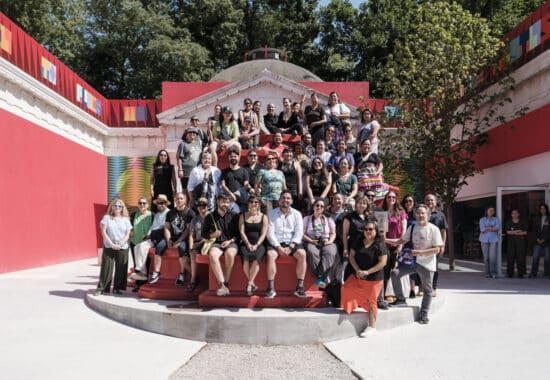Low-Residency Master of Fine Arts in Studio Arts
The Low-Residency MFA in Studio Arts (MFASA) is an interdisciplinary program centered on the production of Indigenous arts. The MFASA two-year, low-residency curriculum is grounded in Indigenous cultural perspectives and reflects the history and challenges of our time. The program provides world-class contemporary art education and empowers its students to give voice to the Indigenous experience through their art. By engaging Indigenous art history and discussions on contemporary art’s function, the MFASA program allows students to further develop their own artistic style and locate their place in the contemporary art world. The MFASA Master Artist Mentors are prominent Indigenous artists with a high level of professional achievement and artistic excellence in their fields.
The low-residency model provides a professional degree in Studio Arts while allowing students to live at home and stay connected to work, family, and community. In addition to their online coursework, students gather twice a year with Master Artist Mentors and guest speakers on the IAIA campus for an intensive residency where they have the opportunity to build community and deepen their understanding of art discourse in an in-person setting, taking advantage of IAIA’s location to engage with local Indigenous communities as well as the various arts institutions that define Santa Fe, New Mexico as a leading cultural center.
For more information, please contact mfasa@iaia.edu
Learning Outcomes
Students in the MFA in Studio Arts will be able to:
- Demonstrate enhanced critical understanding of their work within a multidisciplinary Indigenous context
- Practice self-directed learning and self-defined research projects
- Apply professional studio arts practice towards a fine arts career

IAIA students, mentors, faculty, staff, alum, and community members at the US Pavilion at the Venice Biennale in June 2024.
The Low-Residency Model
The low-residency model provides a professional degree in Studio Arts while allowing students to live at home and stay connected to work, family, and community.
The degree requires the completion of 60 credit hours and is designed as a two-year, low–residency program with two intensive on-campus residency periods per year (summer and winter) on the IAIA campus in Santa Fe, NM.
At the end of each on-campus residency, students are paired with a Master Artist Mentor with whom they will work one-on-one, virtually, during the following 16-week semester. Master Artist Mentors are prominent Native artists who have a high level of professional achievement and artistic excellence in their fields. Students have the opportunity to work with several Master Artist Mentors in the development of their creative work over two years, while also pursuing a research topic for the Master’s Thesis Project specific to their areas of inquiry and interest.
The mentorships are complemented by a series of online Art History courses as well as intensive residencies offering artist lectures, professional workshops, exhibitions, and peer critique of work, and an opportunity to engage with a diverse community of artists.
Deadline and Application
The deadline to apply for each Fall semester is February 15 each year. For information on Tuition and the Degree Plan, see Tuition and the college catalog.
How the Program Works
The Graduate Studio Arts Department is guided by the core values of respect, integrity, creativity, and excellence, and holds these values as essential to professional growth and to building strong leaders who will make a difference.
Our two-year, low–residency curriculum is grounded in Indigenous cultures and reflects the history and challenges of our time. The program provides a world-class contemporary arts education and empowers its students to give voice to the Indigenous experience through their art. IAIA’s Graduate Studio Arts Department is committed to graduating successful artists whose contributions are recognized nationally and internationally within a global art context.
Overview of the Program
The Low–Residency MFA in Studio Arts (MFASA) program begins with a Summer Residency on campus in Santa Fe. During the residency, all new and returning students and mentors gather for an immersive week of workshops, critiques, artist lectures, and panel discussions. The residency experience is characterized by strong peer exchange and dialogue. The lectures and workshops are designed to assist students in developing their visual language as well as their research, writing, and critique skills.
At the conclusion of the Summer Residency, students are paired with a Master Artist Mentor, with whom they will work one-on-one with for the 16-week fall mentorship semester. The residency comprises a 3-credit course, co-requisite with the 9-credit semester-long mentorship course. The mentorship is delivered through an online educational platform and involves regular (virtual) interaction between students and their Mentors.
Students, Mentors, and Visiting Artists gather again on the IAIA campus for a Winter (Pre-Spring Semester) Residency each January, which follows the same format as the summer where students present and critique new and developing work and further their Visual Culture Research Project.
One of the main components of a student’s course of study in the MFASA program is a semester-long Studio Project in which the student develops and/or challenges specific aspects of their art practice under the guidance of a Master Artist Mentor. Each Mentor is asked to engage the student in a rigorous and critical dialogue concerning the conceptual and material issues they confront in their work. Additionally, the student will have chosen a focus area for their Visual Culture research and will be required to respond to books, research, or exhibitions relevant to their focus area.
The dialogue between the Mentor and student generally focuses on the ideas that inform the student’s work, intention vs. execution, formal aesthetic qualities, the relationship of the work to other artists and/or other traditions of art making, and their work’s overall relation to their artistic goals and to current social and cultured contexts in which their work exists. This dialogue should support each student’s individual Studio Study Plan, which students generate prior to the beginning of each semester based on their art practice and its associated inquiries and demands.
The first and second semesters are devoted to generating creative work as well as to developing a critical reading and writing practice centered around the student’s Visual Culture research. The third semester continues the creative and critical work and requires the student to develop a thesis proposal. During the fourth and final semester, the student assembles their studio work into a culminating thesis exhibition, and submits a written MFASA thesis.
Alongside the one-on-one mentorship between the student and Mentor, each student will be enrolled in an Art History online course. These courses are meant to be complementary to the student’s creative work and mentorship.
Facilities
Students engage with our facilities primarily during our in-person residencies, which take place mid-summer and in January. During these residencies, the MFA in Studio Arts is headquartered in the Academic Building, with various activities scheduled throughout campus. Because this is a low-residency program, students do not have access to studio facilities otherwise.
Philosophy
The Low-Residency Master of Fine Arts in Studio Arts Department is committed to graduating successful artists whose contributions are recognized nationally and internationally within a global art context. Our two-year curriculum is grounded in Indigenous cultures and reflects the history and challenges of our time. The program provides world-class contemporary arts education and empowers its students to give voice to the Indigenous experience through their art.
Application
The graduate application for the MFA in Studio Arts is available online. Please note that although the Low–Residency MFA Program begins with an on-campus residency in the summer, that residency is considered part of the Fall semester. Please choose “Fall,” not “Summer,” on the application. If you find you need to submit additional materials, please email those documents to: admissions@iaia.edu or mail them to the Admissions Office at the address below. Your application will not be considered for admission until it is complete.
To process your application, we will need:
- Completed Online Admissions Application
- A $25 non-refundable application fee
- Two letters of recommendation
- Official college transcripts confirming your bachelor’s degree or highest degree earned.
- Personal Statement (see requirements)
- Portfolio of Work (requirements)
Once we have received all of your application materials, your application will be reviewed. Materials must be received by February 15. There is no separate application for scholarships—students who apply before the deadline will be considered for all IAIA scholarships.
A bachelor’s degree is required, but you need not be a Studio Arts major.
Should you be accepted into the program, you will need to pay a $200 deposit by May 15 in order to hold your place.
For questions about the application process, please contact admissions at admissions@iaia.edu.
Personal Statement
Submit a statement (not to exceed 1000 words) that describes your trajectory as an artist. It should cover:
- How have you arrived at your current practice? What are the social, historical, and/or cultural perspectives that have come to inform your work?
- What do expect to achieve through your MFA education? How do you plan to use the resources provided by the program to develop your art practice?
In other words, your statement should address how you’ve gotten to where you are as an artist and then discuss what you hope to accomplish during your time as an IAIA MFA in Studio Arts student.
Portfolio of Creative Work
Submit a portfolio that demonstrates a sustained, focused body of work over an extended period.
Visual Portfolio Specifications:
- Submit 20 images representing work that was completed within the last three years.
- Label each image with the following information
- Title
- Date
- Medium
- Dimensions
- Location, if significant to the work.
Please compile these images and their labels into one pdf not to exceed 7MB.
Video, Performance, Time-Based Work Specifications:
- If you are working in video or performance, please submit links (without password protection) to up to 15 minutes of video files.
- If you are working in audio, you may submit links to up to 10 minutes of audio files.
- With all time-based media, please indicate:
- Title
- Medium
- Duration
- Date of completion
Housing Application
On-campus housing is only available during the summer residencies and only for the duration of the residency. Students who are accepted into the program will be emailed housing application instructions prior to the Summer residency.

Mario A. Caro, PhD
(Colombian Mestizo)
Director
Studio Arts (MFA)
P (505) 428-5929
E mario.caro@iaia.edu

Dawn Double Blaze
(Diné/Blackfeet)
Studio Arts (MFA)
P (505) 424-2330
E dawn.doubleblaze@iaia.edu